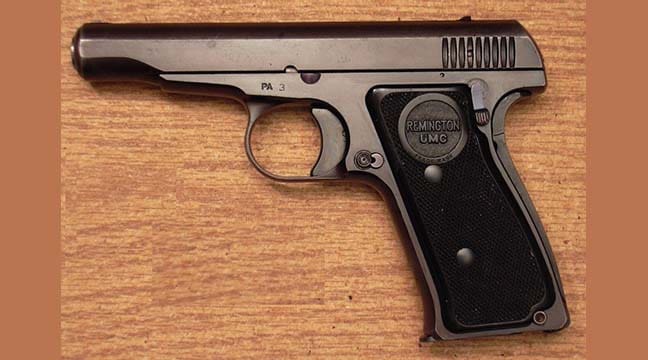
If someone told you the Springfield M1903, the gun carried by the thousands in World War I, wasn’t a bolt-action rifle but was instead an automatic pistol, you’d probably be confused.
Except that whole automatic pistol statement is 100% true. Sort of.
John Pedersen was an arms designer whom John Moses Browning once called “the greatest gun designer in the world.” While working for Remington, he helped design their original Model 51 pistol and collaborated with Browning to develop what became the Ithaca Model 37. However, that’s not what he’s most known for inventing.
Instead, Pedersen is best known for turning a bolt-action rifle into an automatic pistol – better known simply as the Pedersen Device. Just six months after the United States entered WWI, Pedersen met with Chief of Ordnance General Crozier, some of his officers (including Major General Julian Hatcher), and some Congressmen at the Congress Heights Rifle Range. Today, the area where the range stood is a neighborhood complete with an elementary school, credit union, and an IHOP. Back in 1917, Congress Heights Rifle Range was a 167-acre government-owned property in southeast Washington, D.C.
It was on this rifle range that Pedersen planned to show the military something they had never seen before. He took a Springfield M1903 rifle, removed the bolt, inserted his new device and locked it in place. He then inserted a 40-round magazine and began firing as fast as he could pull the trigger.
The men stood there in awe of what Pederson had just done. In his published notebook, Maj. Gen. Hatcher referred to Pedersen’s device as a “mysterious looking piece of mechanism” that converted the rifle into a “one-man machine gun.”
After the demonstration, Pedersen let the men get a closer look at what he had created. They discovered that his device allowed for easy swapping back and forth between his creation and the standard bolt. He showed them the magazine and its .30 caliber cartridges that were about one-fifth the length of a .30-caliber rifle cartridge. Operating in a straight blowback design, spent cartridges were ejected from a port in the left side of the device.
Recognizing the importance of the design, an officer boarded a ship bound for France to give General Pershing a demonstration. This resulted in Pershing ordering 100,000 of the new devices to be created as quickly as possible and with the utmost secrecy. This secrecy even extended to the official name, which is somewhat misleading: “Automatic Pistol, Caliber .30, Model 1918.”
In addition to an order of 100,000 unit to be made by Remington, Pedersen adapted the device to the British Enfield M1917 and they ordered 500,000. Unfortunately for Pedersen, the war ended in November 1918 before the device could be pressed into service for a planned surprise attack in the spring of 1919.
About 65,000 had been produced before the orders were cancelled. The military hung onto them until 1931 when they were declared surplus and ordered to be destroyed in a large fire. As a result, less than 100 remain today and they are highly collectible.
With all of that now explained, it becomes clear why someone could indeed tell you that the Springfield M1903 was actually an automatic pistol and be 100% correct. Sort of.
Logan Metesh is a firearms historian and consultant who runs High Caliber History LLC. Click here for a free 3-page download with tips about caring for your antique and collectible firearms.




Wasn’t the short .30 round used in this device tweaked into the .30 carbine round?
No, .30 Carbine was based on the old Winchester .32, which had been around since about 1905.
Love me some history. Thanks for that one.
It’s not a pistol unless you remove the shoulder stock.
I believe there was some slight modification of the rim but they were essentially .32 ACP.
The Pederson Device is awesome, It would be awesome to see some reproductions out there. Dubious it will ever happen since they are hard to come by to even reverse engineer.
Oh, on another topic that R51 is awesome. Would totally love to have one.
7.65x20mm French Longue. Was the .30 caliber cartridge it used. Very neat! Thank you for the write up
“Hatcher’s Notebook” a must read/shelf reference for every shootist.
+1
A coworker handed it to me one day and said to read it. I couldn’t put it down. It took me a couple weeks, but was filled with lots of interesting insights and anecdotes.
Growing up my father introduced me once to a WWII collector and friend that actually still has one of these. He’s got the whole device, kit, manual, etc. and it was pretty cool seeing this in person.
I need one for my 1903 now
It wasn’t an accessory for regular 1903s; The rifles fitted with the Device (it replaced the bolt assembly) had some changes to the sear, trigger, and magazine cut-off, and also had an ejection port milled into the left side of the receiver. This work didn’t prevent them from being used without the Pederson Device as regular .30-’06 rifles, so the converted rifles weren’t scrapped when the Devices were destroyed, and remained in service along with regular 1903s.
Why no picture of the device.
How about video? Ian gets a little creative in his enactment of a “briefing” that could have been, but he does demonstrate the device in full video.
https://www.full30.com/video/22322a42716817448b6136e568a0e191
M1917 was an American rifle, the “American Enfield.”
That’s it! I’m gonna take 8mm Mauser ammo, cut the brass casing down by 1/3rd, call it 8mm Blackout and build one of these devices for my Yugo Mauser. Anyone wanna GoFundMe?
So, why is no-one producing Pedersen devices for modern and milsurp bolt-action rifles?
Comments are closed.